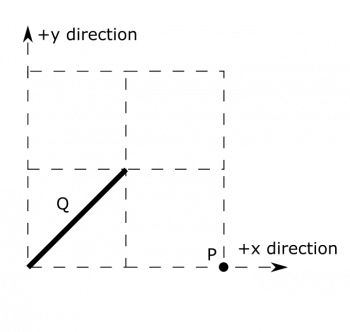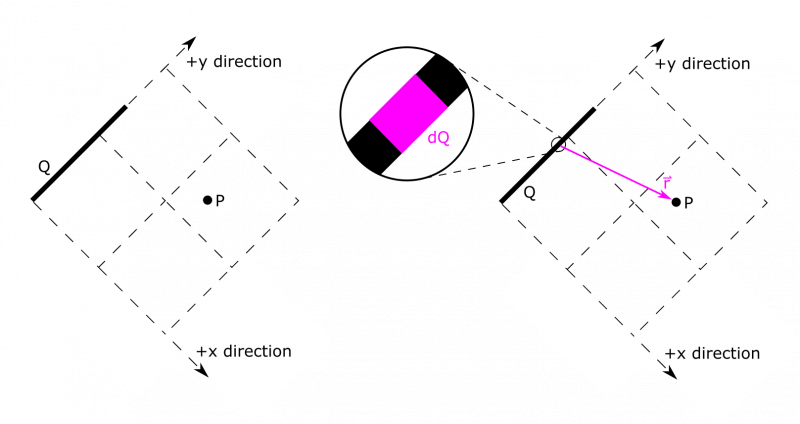This is an old revision of the document!
Example: A Tilted Segment of Charge
Suppose we have a segment of uniformly distributed charge stretching from the point $\langle 0,0,0 \rangle$ to $\langle 1 \text{ m}, 1 \text{ m}, 0 \rangle$, which has total charge $Q$. We also have a point $P=\langle 2 \text{ m},0,0 \rangle$. Define a convenient $\text{d}Q$ for the segment, and $\vec{r}$ between a point on the segment to the point $P$. Also, give appropriate limits on an integration over $\text{d}Q$ (you don't have to write any integrals, just give appropriate start and end points). First, do this for the given coordinate axes. Second, define a new set of coordinate axes to represent $\text{d}Q$ and $\vec{r}$ in a simpler way and redo.
Facts
- The segment stretches from $\langle 0,0,0 \rangle$ to $\langle 1 \text{ m}, 1 \text{ m}, 0 \rangle$.
- The segment has a charge $Q$, which is uniformly distributed.
- $P=\langle 2 \text{ m},0,0 \rangle$.
Lacking
- $\text{d}Q$ and $\vec{r}$
- A new set of coordinate axes
Approximations & Assumptions
- The thickness of the segment is infinitesimally small, and we can approximate it as a line segment.
- The total charge is a constant - not discharging.
Representations
- For the first part, we can draw a set of coordinate axes using what we already know. The first part of the example involves the following orientation:
- We can represent $\text{d}Q$ and $\vec{r}$ for our line as follows:
- For the second part when we define a new set of coordinate axes, it makes sense to line up the segment along an axis. We choose the $y$-axis. We could have chosen the $x$-axis, and arrived at a very similar answer. Whichever you like is fine!
Solution

In the first set of axes, the segment extends in the $x$ and $y$ directions. A simple calculation of the Pythagorean theorem tells us the total length of the segment is $\sqrt{2}$, so we can define the line charge density $\lambda=Q/\sqrt{2}$. When we define $\text{d}l$, we want it align with the segment, so we can have $\text{d}l=\sqrt{\text{d}x^2+\text{d}y^2}$. Since $x=y$ along the segment, we can simplify a little bit. $\text{d}l=\sqrt{\text{d}x^2+\text{d}x^2}=\sqrt{2}\text{d}x$. Now, we can write an expression for $\text{d}Q$:
$$\text{d}Q=\lambda\text{d}l=\frac{\sqrt{2}}{\sqrt{2}}Q\text{d}x=Q\text{d}x$$

The units here might look a little weird, since distance was defined without dimensions in the example statement. Next, we need $\vec{r}$. We will put it in terms of $x$, not $y$, just as we did for $\text{d}Q$. 
In the second set of axes, the segment extends only in the $y$ direction. This problem is now very similar to the examples in the notes. The length of the segment is still $\sqrt{2}$, so we can define the line charge density $\lambda=Q/\sqrt{2}$. When we define $\text{d}l$, we want it align with the segment, which is much simpler this time: $\text{d}l=\text{d}y$. Now, we can write an expression for $\text{d}Q$:
$$\text{d}Q=\lambda\text{d}l=\frac{Q\text{d}y}{\sqrt{2}}$$
Next, we need $\vec{r}$. We will put it in terms of $y$, just as we did for $\text{d}Q$. The location of $P$ is a little different with this new set of axes. Now, we have $\vec{r}_P=\langle \sqrt{2},\sqrt{2},0 \rangle$, and $\vec{r}_{\text{d}Q}=\langle 0, y, 0 \rangle$. We have enough to write $\vec{r}$:
$$\vec{r}=\vec{r}_P-\vec{r}_{\text{d}Q}=\langle \sqrt{2}, \sqrt{2}-y, 0 \rangle$$



